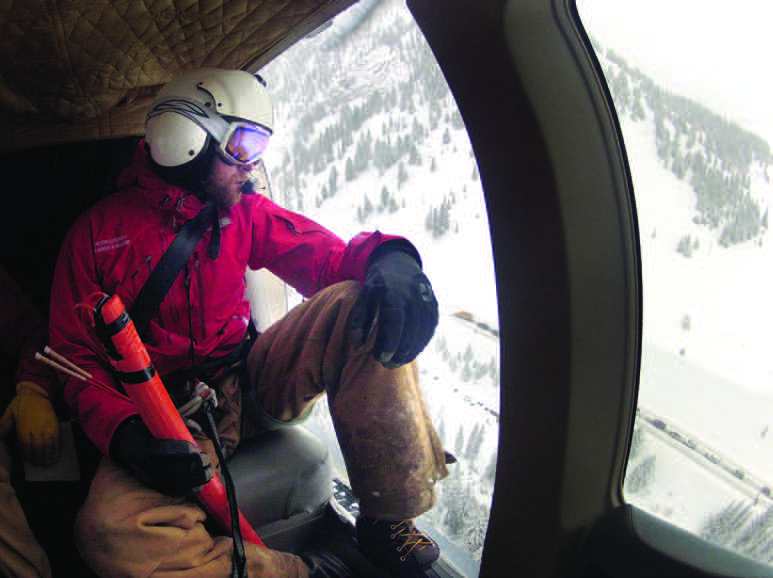Read The
Current Issue
Let It Slide
As avalanche forecaster for the Wyoming Department of Transportation, Jamie Yount’s job is to predict when and where avalanches will happen … and then trigger them.
BY DINA MISHEV
PHOTOGRAPHY BY BRADLY J. BONER

“TO LIVE UP at 10,000 feet year-round and, for six months, to blow up. That’s a hard life,” says Jamie Yount, avalanche forecaster for the Wyoming Department of Transportation (WYDOT). When Yount says “blow up,” he’s being absolutely literal. He’s describing the life of the four GAZEX (pronounced gaz-ex) exploder systems near the top of Glory Bowl and Twin Slides, themselves above the final switchback of Wyoming Highway 22 as it climbs to the summit of Teton Pass. Yount and WYDOT fire the propane- and oxygen-fueled Teton Pass GAZEXes dozens and dozens of times every winter, creating what Yount calls “a pretty big bang.” A powerful air blast roars out of a high-strength steel pipe overhanging the slope. The idea is to trigger an avalanche before one rips loose on its own. “The shock wave sent out by this attenuates through the snow,” Yount explains. “We almost always get snow to move. We might not trigger a big slide, but I’m confident that any instability in the snowpack, it gets it out of there.”
A hard life indeed. Until you compare it with Yount’s own winter stresses. “My worst nightmare is having a natural or skier-triggered avalanche on Teton Pass come to the road and having it get a car,” he says. Across the country, avalanche forecasting is a fairly niche field. “It’s a pretty small community of people who do what I do,” says Yount, thirty-six. “I know the entire community in the U.S.” Most state Departments of Transportation do not require the services of an avalanche forecaster. And not all states that do avalanche control use military artillery. “There are eighteen programs in the country that use artillery for avy control,” Yount says. WYDOT is one of them and all use the same weapon, a M101A1 105mm Howitzer. Each of the eighteen is a member of Avalanche Artillery Users Of North America, of which Yount currently is chair. Seven of the eighteen are Departments of Transportation; the other eleven are ski areas.
Yount doesn’t say this outright, but his job truly is a matter of life and death. Daily, an estimated five thousand cars travel Teton Pass (Hwy 22), one of the three major avalanche areas that fall under the purview of WYDOT District 3’s Jackson office. The other two zones are the Snake River Canyon (U.S. 26/89) and the Hoback River Canyon (U.S. 191/189). Teton Pass gets the most attention from the public, but together, these two canyons have enough avalanche paths that photocopies of photographs of them fill a three-ring binder, which sits—its pages crinkled from age and study—in Yount’s office.
The three main avalanche zones are the reason that, last January and February, with winter storm after winter storm stacked up—dumping rain and snow on the valley floor and fifteen feet at the top of Teton Pass—Yount, along with most everyone else on WYDOT’s snow removal staff, worked forty days in a row. “I don’t really have a schedule. It’s a weather-dependent job. If it’s storming, we’re superbusy; if it’s not, we get caught up,” Yount says.

SITTING DOWN WITH Yount in his sparse, dusty office off the hallway leading out to the equipment/maintenance area in Jackson’s WYDOT administrative building last March, a week or so after his forty-day stretch ended, he was at the tail end of a brutal cold. “I got sick right after the storms ended,” he says. “My body was worn out and beat down and finally gave up.” Over those forty days Yount and twenty-some other WYDOT employees from mechanics to maintenance men, foremen, avalanche control specialists, and engineers worked “lots of early morning hours and lots of late nights,” Yount says.
On a storm day, Yount is often found in his offing poring over weather reports and his own notes by 6 a.m. An avid backcountry skier himself, Yount actually needs to ski laps on Glory for work. “Sometimes it gets too busy for me to hike to the top, but it’s important I at least get to the study plot several times a week,” he says. “If conditions are changing, that’s when it’s most important to get out there and see what’s really happening. Weather reports and the reports we get from the study plot being automated—I can see the amount of and the moisture content of new snow from my office—are great, but you learn so much more if you’re out there.”
“I spend an hour or two on the computer looking at the weather and using my own knowledge to make an avalanche forecast,” he says. “I decide if we need to take action [do control work] and then we try to get a press release out up to twelve hours in advance.” Yount explains WYDOT tries to do control work in the wee hours of the morning. An hour’s closure of Teton Pass during the day is estimated to cause between $8,000 and $10,000 of economic loss. “We take that pretty seriously,” Yount says. Then there’s also the skier factor. Glory Bowl sees an estimated 80,000 runs by skiers and snowboarders every winter. Unlike ski areas with lifts, Glory Bowl has no operating hours. Recreationalists have access to Teton Pass twenty-four hours a day. It seems there are only a handful of hours of every day there isn’t a car in the parking lot at the top. “People ski up there from before daylight to well after dark,” Yount says. “The skiing and the access are so good. It makes it more challenging for us, but who can blame them for wanting to go up there and ski, though?”
When it comes time to fire the artillery or GAZEXes, metal gates go down on both sides of Teton Pass and no cars can get through. The gates stay down until any slide debris they triggered is cleaned up off the road. The idea is to have the gates up in time for the morning commute. “I love days when I have time to actually ski,” Yount says, “but I like avy control days, too. It’s crazy busy. I don’t like forty days in a row of it, but it is exciting.”

THE HOBACK AND Snake River canyons don’t have the skier issues Teton Pass does, but they have difficulties of their own. The terrain in the Hoback Canyon is so rough and gnarly Yount can’t get a firsthand look at the snowpack. “It’s not like Glory. I’ve never been up the paths in the Hoback in the wintertime, and I will never go,” Yount says. “Instead, I go to little test slopes and try to guess from those what’s going on thousands of feet higher up.” Then, the canyon is so narrow and the slide paths above so steep, “almost any sort of small avalanche will make it to the road,” Yount says. Finally, there are no road closure gates in the Hoback Canyon, so there needs to be additional staff to stop cars.
Yount says he feels Glory Bowl is the slide path “we have the best handle on.” Cow in the Woods in Hoback Canyon “gives me so much trouble and so much heartburn. That’s the one I spend a lot of time thinking about. You can’t call them all right all the time. I hate things that get away from me, but it happens and that’s this business.”
Comparing the avalanche danger WYDOT tries to mitigate to those of other programs in the country, Yount says: “Our avalanche problem is not nearly as severe as Little Cottonwood Canyon [Utah] or Red Mountain Pass in Colorado. Red Mountain is probably the most dangerous road in the country, but it has few cars traveling on it. We don’t have the biggest avalanche problem, but average about 5,000 cars a day on Teton Pass. That’s significant.”
AS YOUNT WAS growing up in Bozeman, Montana, his father was director of Bridger Bowl Ski Area’s ski patrol. “Through exposure to that, I got to know guys at the avy center in Bozeman,” Yount says. “From a young age, I thought theirs was the coolest job ever. It was a long-term goal of mine to become one myself.” Yount graduated from the University of Utah with a degree in meteorology in 2002. “Being able to forecast is a big part of what I do,” he says.
WYDOT has a long history of doing avalanche control on Teton Pass, but when he was hired in 2002, Yount was the first dedicated avalanche forecaster in the department. “Before I came on, they would take someone who was an engineer or in maintenance and have him learn about avalanches,” Yount says. “With me, it was, ‘Let’s hire him as an avy guy and teach him to also be a WYDOT guy’ rather than the opposite. It certainly was a good program before I came along, but I like to think I’ve tightened things up a little bit and brought a different perspective. There certainly weren’t any WYDOT guys skiing Glory before I came along. It’s one of my favorite parts of the job.”




